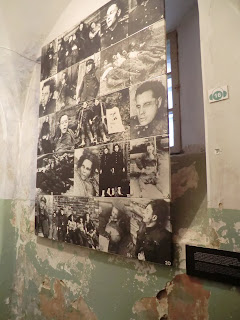
So, while I was well aware of the atrocities committed by the Nazis during WWII, one thing I was not as aware of, however, was the extent of the atrocities committed by the Soviets around Eastern Europe when after WWII they began to occupy many of the countries now considered former soviet republics.
The KGB prison in Vilnius, Lithuania was used in WWII by the Nazis but after the Germans left was occupied by the Soviet KGB. The prison was actually used continually from the end of the war until the Soviet’s were pushed out of Lithuania 1990. Probably the heaviest and most brutal use of the prison was started right after the war until 1953 when Stalin was put out of power. The prison during the entire duration was used to house those who were considered problematic in opposing the communist regime.
Until 1953, some of the torturing and techniques they used were horrendous. There was a lightless room where some people were put for a month in which they were left in their underwear at any time of the year for weeks and fed only piece of bread and a glass of water a day. It loosened up a little after Stalin, but before, the exercise regime for the prisoners consisted of walking in a circle outside for 15 minutes a day, with no talking allowed. In some crowded cells, prisoners were not allowed to touch the walls. One of the torture cells consisted of an empty room with a small concrete pillar in the middle. The room floor was filled with ice and subjects had to stand on top of this tiny concrete pillar just as wide as their feet for days or risk standing on ice. A particularly horrible practice under Stalin was to take dead bodies from the prison and place them in public places in towns to scare relatives and friends into obedience. The prison had a small library, but there are no records of it ever being used to loan books to prisoners.
The cell with the pillar to stand on:

Pictures of bodies placed in towns:

Although policies became less strict (relatively speaking) leading up until 1990, the prison was still used for the entire duration as a center for monitoring all civilians. In general, everyone was watched. Special equipment was used to tap phone calls and the original monitoring rooms were display at the museum. In theory the KGB had to get permission to monitor someone, but in practice nothing was required. Those who were thought to be ‘hostile elements’ to the Soviet system for organizing protests, farmers failing to fulfill their requirements, those who talked negatively about those in power, even at times those who told jokes about the Soviets were registered and then possibly arrested by the KGB. Reasonable arrests were ‘betrayal of the motherland’ or ‘counterrevolutionary activities’ and ‘sabotage’. Sentences were generally 5, 10, or 25 years. Over 200,00 Lithuanians were arrested, interrogated, and imprisoned from 1944-1990 and over 70,000 people died in either the prison, through deportation, or for being a supporter of the opposition. It is pretty amazing to think that all this occurred, probably in all the other republics as well, until about 20 years ago. And the fact that it came immediately after WWII in which 240,000 Lithuanians were killed puts them at close to 50 years of continuous occupation and hardship. Young Lithuanians probably have a lot to be proud of to have grown up in an more or less independent Lithuania.
Pleasant thoughts.
Molotov cocktail:

Padded room:


No comments:
Post a Comment
Post a Comment!